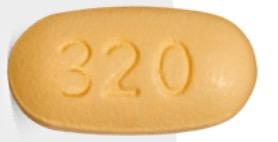Sotorasib Dosage
Medically reviewed by Drugs.com. Last updated on Mar 3, 2025.
Applies to the following strengths: 120 mg; 320 mg; 240 mg
Usual Adult Dose for:
Additional dosage information:
Usual Adult Dose for Non-Small Cell Lung Cancer
960 mg orally once a day
Duration of therapy: Until disease progression or unacceptable toxicity
Comments:
- This indication is approved under accelerated approval based on overall response rate and duration of response; continued approval may depend on verification and description of clinical benefit in confirmatory trial(s).
Use: For the treatment of patients with KRAS G12C-mutated locally advanced or metastatic non-small cell lung cancer (NSCLC), as determined by an FDA-approved test, who have received at least 1 prior systemic therapy
Renal Dose Adjustments
Data not available
Liver Dose Adjustments
Data not available
If hepatotoxicity develops during therapy:
- Grade 2 AST or ALT with symptoms OR Grade 3 to 4 AST or ALT: This drug should be withheld until recovery to Grade 1 or less or baseline; therapy should resume at the next lower dose level.
- First dose reduction: 480 mg orally once a day
- Second dose reduction: 240 mg orally once a day
- AST or ALT greater than 3 times the upper limit of normal (3 x ULN) with total bilirubin greater than 2 x ULN without alternative causes: This drug should be permanently discontinued.
Dose Adjustments
If adverse reactions occur, a maximum of 2 dose reductions are permitted. This drug should be discontinued if patients are unable to tolerate the minimum dose of 240 mg orally once a day.
Dose Reduction for Adverse Reactions:
- First dose reduction: 480 mg orally once a day
- Second dose reduction: 240 mg orally once a day
Dose Modifications for Adverse Reactions:
Interstitial lung disease (ILD)/pneumonitis:
- Any Grade: This drug should be withheld if ILD/pneumonitis is suspected; this drug should be permanently discontinued if ILD/pneumonitis is confirmed.
Nausea or vomiting despite appropriate supportive care (including antiemetic therapy):
- Grade 3 to 4: This drug should be withheld until recovery to Grade 1 or less or baseline; therapy should resume at the next lower dose level.
Diarrhea despite appropriate supportive care (including antidiarrheal therapy):
- Grade 3 to 4: This drug should be withheld until recovery to Grade 1 or less or baseline; therapy should resume at the next lower dose level.
Other adverse reactions:
- Grade 3 to 4: This drug should be withheld until recovery to Grade 1 or less or baseline; therapy should resume at the next lower dose level.
Coadministration with Acid-Reducing Agents:
- Coadministration of proton pump inhibitors and H2-receptor antagonists with this drug should be avoided.
- If treatment with an acid-reducing agent cannot be avoided, this drug should be administered 4 hours before or 10 hours after administration of a local antacid.
Precautions
CONTRAINDICATIONS: None
Safety and efficacy have not been established in patients younger than 18 years.
Consult WARNINGS section for additional precautions.
Dialysis
Data not available
Other Comments
Administration advice:
- Prior to use, select patients based on the presence of KRAS G12C mutation in tumor or plasma specimens; if no mutation is detected in a plasma specimen, test tumor tissue.
- For information on US FDA-approved tests for detection of KRAS G12C: http://www.fda.gov/CompanionDiagnostics
- Administer this drug at the same time each day with or without food.
- Swallow tablets whole; do not chew, crush, or split tablets.
- If patient has difficulty swallowing solids:
- Disperse tablets in 120 mL (4 ounces) of noncarbonated, room-temperature water without crushing; do not use other liquids.
- Stir until tablets are dispersed into small pieces (tablets will not completely dissolve) and drink immediately or within 2 hours; the mixture appearance may range from pale yellow to bright yellow.
- Swallow the tablet dispersion; do not chew pieces of the tablet.
- Rinse the container with an additional 120 mL (4 ounces) of water and drink.
- If not consumed immediately, stir the mixture again to ensure that tablets are dispersed.
- If a dose is missed by more than 6 hours, administer the next dose as prescribed the next day; do not administer 2 doses at the same time to make up for the missed dose.
- If vomiting occurs after dosing, do not administer an additional dose; administer the next dose as prescribed the next day.
Storage requirements:
- Store at 20C to 25C (68F to 77F); excursions permitted from 15C to 30C (59F to 86F).
Monitoring:
- Hepatic: Liver function tests, including ALT, AST, and total bilirubin (before starting therapy, every 3 weeks for first 3 months of therapy, then once a month or as clinically indicated; more often in patients with transaminase and/or bilirubin elevations)
- Respiratory: For new/worsening pulmonary symptoms indicative of ILD/pneumonitis
Patient advice:
- Read the US FDA-approved patient labeling (Patient Information).
- Contact health care provider immediately for signs/symptoms of liver dysfunction or to report new/worsening respiratory symptoms.
- Do not breastfeed during therapy and for 1 week after the last dose.
- Avoid proton pump inhibitors and H2-receptor antagonists while taking this drug; if coadministration cannot be avoided, take this drug 4 hours before or 10 hours after a locally-acting antacid.
- If a dose is missed by more than 6 hours, resume therapy as prescribed the next day.
Frequently asked questions
More about sotorasib
- Check interactions
- Compare alternatives
- Reviews (1)
- Side effects
- During pregnancy
- Drug class: miscellaneous antineoplastics
- Breastfeeding
- En español
Patient resources
Other brands
Professional resources
Other brands
Related treatment guides
See also:
Further information
Always consult your healthcare provider to ensure the information displayed on this page applies to your personal circumstances.


